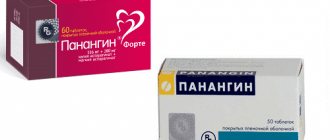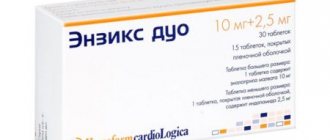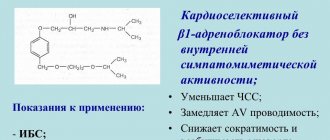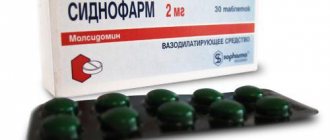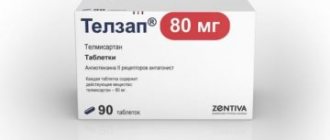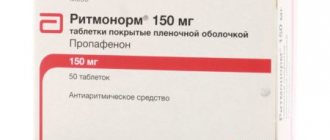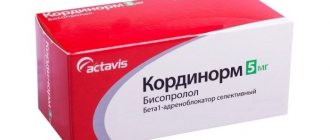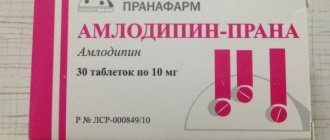The combined antihypertensive drug Noliprel A Bi-forte affects systolic and diastolic pressure.
The combination of two active components enhances each other's action, causing a lasting and effective result.
The medication is a powerful tool in the fight against hypertension. The drug is a popular treatment for people who have suffered from ischemic heart disease or stroke.
Letters from our readers
Topic: Grandma's blood pressure has returned to normal!
From: Christina ( [email protected] )
To: Administration otgipertonii.ru
Christina, Moscow
My grandmother’s hypertension is hereditary - most likely, I will have the same problems as I get older.
I accidentally found an article on the Internet that literally saved my grandmother. She was tormented by headaches and had a repeated crisis. I bought the course and monitored the correct treatment.
After 6 weeks she even started talking differently. She said that her head no longer hurts, but she still takes pills for blood pressure. I am sending a link to the article
Indications for use
The antihypertensive drug Noliprel A Bi-forte is intended for the treatment of high blood pressure (hypertension). Drugs are prescribed in case of ineffectiveness of other hypotonic drugs, if necessary, a dosage of 10/2.5 mg (perindopril and indapamide).
In some cases, the indication for use is to reduce the possible risk of microvascular diseases due to primary hypertension, such as type II diabetes.
Interaction with other drugs
“Noliprel A Bi-forte”, according to the instructions for use, is not recommended to be taken in combination with medications that contain lithium. Such precautions are due to the fact that their combined use can increase the amount of lithium in the blood, resulting in intoxication of the body. Intoxication is especially common during combined treatment with thiazide diuretics. If there is a need for such therapy, it is important to constantly monitor lithium levels in the blood.
Complex treatment should be carried out only under the supervision of a doctor.
The combined use of the described drug together with Baclofen increases the hypotensive property. In such situations, it is important to constantly monitor the patient's health status. Sometimes a dose adjustment of Noliprel Bi-forte is required. The use of non-steroidal anti-inflammatory drugs or acetylsalicylic acid in increased dosages sometimes reduces the hypotensive effect of the described medication. In addition, the association of these drugs affects the functioning of the kidneys and sometimes provokes acute renal failure, as well as increased potassium concentrations in the body. It is important for doctors to pay attention to the combination of these medications and prescribe them with caution, especially to older people.
The simultaneous use of Noliprel A Bi-forte and antidepressants increases the hypertensive effect and increases the likelihood of collapse. Other medications whose action is aimed at lowering blood pressure increase the hypotonic effect of Noliprel A Bi-forte. Glucocorticosteroids retain water and sodium in the body, as a result of which they reduce the antihypertensive effect of the drug being described.
Effect on blood pressure
The main antihypertensive effect is represented by a powerful complex of two substances with different principles of action: perindopril and indapamide. Perindopril belongs to the group of angiotensin-converting enzyme (ACE) inhibitors with the destruction of bradykinin. Indapamide is close to thiazide diuretics and can enhance the diuretic effect.
The combination of active substances leads to a rapid hypotensive effect. Under the influence of perindopril, kinase II is released with a pronounced vasodilatory effect. A reduced level of aldosterone reduces the peripheral vascular resistance in the tissues and muscles of the endocrine system.
Don't tolerate high blood pressure
Now hypertension can be cured by restoring blood vessels...
>
Perindopril enhances the effect when adding the pharmaceutical action of the thiazide sulfonamide - indapamide. By influencing the rate of renal filtration and the excretion of chloride, potassium, sodium and magnesium ions, the active drug provokes a pronounced hypotensive effect.
High blood pressure (both systolic and diastolic) is reduced by the inhibitor and diuretic. Low synthesis of angiotensin leads the vascular bed to an “expanded” state, and the diuretic effect enhances the removal of excess fluid from the body.
The medicine has a beneficial effect on the condition of the left ventricle in the presence of its hypertrophy. The therapeutic effect does not depend on the intensity of the pathological process. The pharmacological effect lasts for 24 hours. It does not affect lipid metabolism, that is, the level of high and low density cholesterol, as well as triglycerides.
Substances undergo adsorption in the gastrointestinal tract and subsequently bind to blood proteins, where they become active metabolites. The main route of excretion is the kidneys, in smaller quantities – the intestines.
Noliprel A Bi-forte
NoliprelR A Bi-forte is a combination drug containing perindopril arginine and indapamide. The pharmacological properties of the drug combine the individual properties of each of its active components.
Mechanism of action
The combination of perindopril arginine and indapamide enhances the antihypertensive effect of each of them.
Perindopril
Perindopril is an inhibitor of the enzyme that converts angiotensin I to angiotensin II (ACE inhibitor). ACE, or kininase II, is an exopeptidase that carries out both the conversion of angiotensin I into the vasoconstrictor substance angiotensin II, and the destruction of bradykinin, which has a vasodilatory effect, into an inactive heptapeptide. As a result, perindopril reduces the secretion of aldosterone, according to the principle of negative feedback, increases the activity of renin in the blood plasma, and with long-term use reduces the peripheral vascular resistance, which is mainly due to the effect on the vessels in the muscles and kidneys. These effects are not accompanied by sodium or fluid retention or the development of reflex tachycardia.
Perindopril normalizes myocardial function, reducing preload and afterload. When studying hemodynamic parameters in patients with chronic heart failure, the following was revealed: a decrease in filling pressure in the left and right ventricles of the heart; decrease in OPSS; increased cardiac output and increased cardiac index; increased muscle peripheral blood flow.
Indapamide
Indapamide belongs to the group of sulfonamides; its pharmacological properties are similar to thiazide diuretics. Indapamide inhibits the reabsorption of sodium ions in the cortical segment of the loop of Henle, which leads to an increase in the excretion of sodium, chlorine and, to a lesser extent, potassium and magnesium ions by the kidneys, thereby increasing diuresis and reducing blood pressure.
Antihypertensive effect
The drug has a dose-dependent antihypertensive effect on both diastolic and systolic blood pressure in the standing and lying position. The antihypertensive effect of the drug lasts for 24 hours. A stable therapeutic effect occurs less than 1 month from the start of therapy and is not accompanied by tachycardia. Stopping treatment does not cause withdrawal syndrome.
The drug reduces the degree of left ventricular hypertrophy, improves arterial elasticity, reduces peripheral vascular resistance, and does not affect lipid metabolism (total cholesterol, HDL-cholesterol and LDL-cholesterol, triglycerides).
The effect of the combination of perindopril and indapamide on left ventricular hypertrophy (LVH) compared with enalapril has been proven. In patients with arterial hypertension and LVH who received therapy with perindopril erbumine 2 mg (equivalent to 2.5 mg perindopril arginine)/indapamide 0.625 mg or enalapril at a dose of 10 mg 1 time / day, and with an increase in the dose of perindopril erbumine to 8 mg (equivalent to 10 mg perindopril arginine) and indapamide up to 2.5 mg, or enalapril up to 40 mg 1 time/day, a more significant decrease in left ventricular mass index (LVMI) was noted in the perindopril/indapamide group compared to the enalapril group. In this case, the most significant effect on LVMI is achieved with the use of perindopril erbumine 8 mg/indapamide 2.5 mg.
A more pronounced antihypertensive effect was also noted during combination therapy with perindopril and indapamide compared to enalapril.
Perindopril
Perindopril is effective in the treatment of arterial hypertension of any severity.
The antihypertensive effect of the drug reaches its maximum 4-6 hours after a single oral dose and persists for 24 hours. 24 hours after taking the drug, pronounced (about 80%) residual ACE inhibition is observed.
Perindopril has an antihypertensive effect in patients with both low and normal plasma renin activity.
The simultaneous administration of thiazide diuretics increases the severity of the antihypertensive effect. In addition, the combination of an ACE inhibitor and a thiazide diuretic also reduces the risk of hypokalemia while taking diuretics.
Indapamide
The antihypertensive effect occurs when the drug is used in doses that have a minimal diuretic effect. The antihypertensive effect of indapamide is associated with an improvement in the elastic properties of large arteries and a decrease in peripheral vascular resistance. Indapamide reduces LVOT. Indapamide does not affect the concentration of lipids in the blood plasma: triglycerides, total cholesterol, LDL, HDL; carbohydrate metabolism (including in patients with concomitant diabetes mellitus).
Use by the elderly
It is allowed for use in elderly and elderly people, but careful monitoring of filtration capacity is necessary. When QC is less than 60 ml/min, dose correlation is necessary.
When using the drug Noliprel A Bi-Forte in elderly people, severe liver disease should be taken into account.
Compound
Noliprel A Bi Forte contains active ingredients that determine the action of the pharmacological agent. Achieving the required structure, stability and absorption rate is achieved through additional components.
Table 1. Composition
| Component | Influence |
| Active | |
| Perindopril arginine | Helps slow down the synthesis of the hormone, which leads to an increase in blood pressure. Effectively dilates blood vessels. When used as a course, it reduces the total peripheral vascular resistance. Stimulates muscle blood flow. It has a cardioprotective and angioprotective effect. Reduces the load on the muscle tissue of the heart. |
| Indapamide | Helps increase the amount of urine, accelerates the excretion of certain mineral ions, as a result of which blood pressure decreases |
| Additional | |
| Lactose | One of the powerful sources of energy, drug filler |
| Stearic acid | Emulsifier and stabilizer, preservative |
| Syrup | Stabilizer, thickener, filler |
| Silica | Emulsifier |
| Sodium carboxymethyl starch | Humidifier, stabilizer |
Instructions for use of Noliprel Bi Forte also contain information on the number of components and the composition of the tablet shell.
Side effects
Taking a pharmaceutical drug may be accompanied by systemic symptoms that are a consequence of side effects:
- confusion;
- severe hypotension;
- dizziness and fainting;
- bronchospasm;
- dry cough;
- hearing impairment;
- lack of appetite;
- insomnia and confusion;
- hives;
- hemorrhagic vasculitis;
- swelling of the face and limbs.
From the circulatory system, an increase in the concentration of ALT, AST, bilirubin and creatinine is possible. There are no platelets in the peripheral blood (or very few), the blood smear contains predominantly agranulocytes and signs of developing hemolytic anemia.
In the case of diseases of the genitourinary system, protein is detected in the urine, as well as uric acid crystals in the sediment. The body may lack potassium, sodium and water - dehydration develops.
Side effects
Even a drug recommended by a specialist can lead to negative consequences in some people. Noliprel A Bi Forte, reviews of which confirm this information, can also cause side effects.
Table 3. Possible side effects
| The cardiovascular system | Tachycardia, arrhythmia, myocardial infarction, drop in blood pressure, etc. |
| central nervous system | Irritability, anxiety, sleep disturbance, etc. |
| Genitourinary system | Increased diuresis, decreased libido, decreased potency, etc. |
| Allergic reactions | Anaphylactic shock, urticaria, eczema, angioedema, etc. |
| Respiratory system | Pneumonia, dry cough, rhinitis, etc. |
| Gastrointestinal tract | Nausea, vomiting, diarrhea, drug-induced hepatitis, etc. |
| Sense organs | Extraneous noise in the ears, taste of metal, etc. |
| Other | Excessive sweating. |
Side effects may differ from those shown in the table. The full list can be read in the instructions for use.
Contraindications
An effective antihypertensive agent has a number of contraindications for use. This fact is due to the complex action of active substances. These include:
- intolerance to the components of the drug;
- period of gestation or breastfeeding;
- age less than 18 years;
- lactase deficiency with malabsorption syndrome;
- decreased potassium levels in the blood;
- Severe heart failure;
- severe urinary system diseases;
- hepatic encephalopathy;
- galactosemia;
- hypokalemia.
The drug is prescribed with caution for diabetes mellitus, suppression of the hematopoietic system and aortic valve stenosis.
A history of angioedema can become an obstacle to the use of medication, because the disease may recur.
Enalapril forte
Symptomatic hypotension
Symptomatic hypotension is rarely observed in patients with uncomplicated hypertension. In patients with hypertension taking Enalapril FORTE, arterial hypotension develops more often against the background of dehydration, which occurs, for example, as a result of diuretic therapy, limiting salt intake, in patients on dialysis, as well as in patients with diarrhea or vomiting (see sections “Side effects”; “Interaction with other drugs”). Symptomatic hypotension is also observed in patients with heart failure with or without renal failure.
Arterial hypotension develops more often in patients with more severe HF with hyponatremia or impaired renal function in whom higher doses of loop diuretics are used. In these patients, treatment with the drug should be started under medical supervision, which should be especially careful when changing the dose of the drug and/or diuretic. Similarly, patients with coronary heart disease or cerebrovascular disease, in whom an excessive decrease in blood pressure may lead to the development of myocardial infarction or stroke, should be monitored.
If arterial hypotension develops, the patient should be laid down and, if necessary, a 0.9% sodium chloride solution should be administered. Transient arterial hypotension when taking the drug is not a contraindication to further use and increasing the dose of the drug, which can be continued after replenishment of fluid volume and normalization of blood pressure.
In some patients with heart failure and normal or low blood pressure, the drug may cause an additional decrease in blood pressure. This reaction to taking the drug is expected and is not a reason to stop treatment. In cases where arterial hypotension becomes stable, the dose should be reduced and/or treatment with a diuretic and/or drug should be discontinued.
Aortic or mitral stenosis/hypertrophic obstructive cardiomyopathy
Like all drugs that have a vasodilating effect, ACE inhibitors should be administered with caution to patients with left ventricular outflow tract obstruction.
Renal dysfunction
In some patients, hypotension that develops after initiation of treatment with ACE inhibitors may lead to further deterioration of renal function. In some cases, the development of acute renal failure, usually reversible, has been reported.
In patients with renal failure, it may be necessary to reduce the dose and/or frequency of taking the drug (see section "Dosage and Administration"). In some patients with bilateral renal artery stenosis or arterial stenosis of a solitary kidney, increases in blood urea and serum creatinine concentrations were observed. The changes were usually reversible, and indicators returned to baseline values after cessation of treatment. This pattern of changes is most likely in patients with renal failure.
In some patients who did not have renal disease before treatment, the drug in combination with diuretics usually caused a slight and transient increase in the concentration of urea in the blood and creatinine in the serum. In such cases, it may be necessary to reduce the dose and/or discontinue the diuretic and/or Enalapril FORTE.
Kidney transplant
There is no experience of use in patients after kidney transplantation, therefore treatment with Enalapril FORTE is not recommended in patients after kidney transplantation.
Liver failure
The use of ACE inhibitors is rarely associated with the development of a syndrome that begins with cholestatic jaundice or hepatitis and progresses to fulminant liver necrosis, sometimes fatal. The mechanism of this syndrome has not been studied. If jaundice appears or a significant increase in the activity of “liver” transaminases during the use of ACE inhibitors, the drug should be discontinued and appropriate auxiliary therapy should be prescribed, the patient should be under appropriate supervision.
Neutropenia/agranulocytosis
Neutropenia/agranulocytosis, thrombocytopenia and anemia are observed in patients taking ACE inhibitors. Neutropenia occurs rarely in patients with normal renal function and no other complicating factors.
Enalapril FORTE should be used with extreme caution in patients with systemic connective tissue diseases (systemic lupus erythematosus, scleroderma, etc.) taking immunosuppressive therapy, allopurinol or procainamide, or a combination of these complicating factors, especially if there are already existing renal dysfunctions. Some of these patients develop serious infectious diseases, which in some cases do not respond to intensive antibiotic therapy. If enalapril is used in such patients, regular monitoring of white blood cell and lymphocyte counts is recommended and patients should be warned to report any signs of infectious disease.
Hypersensitivity reactions/angioedema
When using ACE inhibitors, including Enalapril FORTE, rare cases of angioedema of the face, extremities, lips, tongue, vocal folds and/or larynx have been observed, occurring during different periods of treatment. In very rare cases, intestinal edema may develop. In such cases, you should immediately stop taking the drug and carefully monitor the patient's condition in order to monitor and correct clinical symptoms. Even in cases where only swelling of the tongue is observed without the development of respiratory distress syndrome, patients may require long-term observation, since therapy with antihistamines and corticosteroids may not be sufficient.
Death due to angioedema associated with laryngeal edema or tongue edema has been very rarely reported. Swelling of the tongue, vocal folds, or larynx can lead to airway obstruction, especially in patients who have undergone respiratory surgery. In cases where swelling is localized in the area of the tongue, vocal folds or larynx and can cause airway obstruction, appropriate treatment should be immediately prescribed, which may include subcutaneous injection of 0.1% epinephrine (adrenaline) solution (0.3-0.5 ml) and/or ensure airway patency.
In black patients taking ACE inhibitors, angioedema is observed more often than in patients of other races.
Patients with a history of angioedema not associated with taking ACE inhibitors may be at greater risk of developing angioedema during therapy with ACE inhibitors (see section "Contraindications").
Anaphylactoid reactions during desensitization with an allergen from Hymenoptera venom
In rare cases, patients taking ACE inhibitors develop life-threatening anaphylactoid reactions during desensitization with hymenoptera venom allergen. Adverse reactions can be avoided if you temporarily stop taking the ACE inhibitor before starting desensitization.
Anaphylactoid reactions during LDL apheresis
Life-threatening anaphylactoid reactions are rarely observed in patients taking ACE inhibitors during LDL apheresis using dextran sulfate. The development of these reactions can be avoided if the ACE inhibitor is temporarily discontinued before each LDL apheresis procedure.
Patients on hemodialysis
Anaphylactoid reactions have been observed in patients on dialysis using high-flux membranes (such as AN 69®) and concomitantly receiving ACE inhibitor therapy. In these patients, it is necessary to use a different type of dialysis membrane or other classes of antihypertensive drugs.
Cough
Cases of cough occurring during therapy with ACE inhibitors have been observed. As a rule, the cough is non-productive, persistent and stops after discontinuation of therapy. Cough associated with the use of ACE inhibitors should be considered in the differential diagnosis of cough.
Surgery/general anesthesia
During major surgery or general anesthesia with the use of drugs that cause an antihypertensive effect, enalaprilat blocks the formation of angiotensin II caused by the compensatory release of renin. If a pronounced decrease in blood pressure develops, explained by a similar mechanism, it can be corrected by increasing the volume of circulating blood.
Hyperkalemia
(see section "Interaction with other drugs")
The risk of hyperkalemia occurs in patients with renal failure, diabetes mellitus, and concomitant use of potassium-sparing diuretics (eg, spironolactone, eplerenone, triamterene, or amiloride), potassium supplements, or potassium-containing salts.
The use of potassium supplements, potassium-sparing diuretics, or potassium-containing salts, especially in patients with impaired renal function, may lead to a significant increase in serum potassium levels. Hyperkalemia can lead to serious, sometimes fatal arrhythmias.
If it is necessary to use the drug simultaneously with the drugs listed above, caution should be exercised and the potassium content in the blood serum should be regularly monitored.
Hypoglycemia
Patients with diabetes mellitus taking oral hypoglycemic agents or insulin should be informed before starting the use of ACE inhibitors of the need for regular monitoring of blood glucose concentrations (hypoglycemia), especially during the first month of simultaneous use of these drugs (see section “Interactions”) with other drugs").
Lithium preparations
The simultaneous use of lithium preparations and Enalapril FORTE is not recommended (see section “Interaction with other drugs”).
Dual blockade of the renin-angiotensin-aldosterone system
Hypotension, syncope, stroke, hyperkalemia and renal dysfunction (including acute renal failure) have been reported in susceptible patients, especially when combined therapy with drugs that affect the RAAS is used (see section "Interactions with other drugs"). . Double blockade of the RAAS by combined use of ACE inhibitors with ARA II or aliskiren is not recommended.
Concomitant use of the drug with aliskiren or aliskiren-containing drugs is contraindicated in patients with diabetes mellitus and/or impaired renal function (GFR less than 60 ml/min/1.73 m2) (see section “Contraindications”).
Use in elderly patients
The effectiveness and safety of Enalapril FORTE are similar in older and younger patients with hypertension.
Race
As with the use of other ACE inhibitors, the drug Enalapril FORTE appears to be less effective in reducing blood pressure in patients of the Black race than in patients of other races, which may be explained by the higher prevalence of conditions with low plasma renin activity in the population of Black patients with AG.
Overdose
Exceeding the permissible daily concentration primarily leads to dyspeptic syndrome and hypotension. There is dizziness, loss of orientation and lightheadedness. Often, the symptoms of an overdose become similar to signs of side effects while taking the medication.
The development of renal failure and imbalance of the electrolyte composition of the blood is allowed. Increased urination can lead to dehydration.
Treatment of overdose consists of taking enterosorbents, for example, activated carbon or Polysorb MP. If you feel unwell and have low blood pressure, you should seek specialized help.
Use during pregnancy
When planning pregnancy or bearing a child, it is not recommended to take Noliprel.
If a woman has previously used such pills, the course should be completed and contact the doctor so that he can prescribe another drug.
There have been no studies of the effects of ACE inhibitors on the body of pregnant women. It is still not known exactly how the drug affects fetal development.
Therefore, you need to be careful. After all, there is a risk that the active ingredients of the medication may negatively affect the formation of the skull bones and the functioning of the newborn’s kidneys. The likelihood of arterial hypotension also increases.
This medicine is also contraindicated during breastfeeding, as it suppresses lactation and reduces the amount of breast milk in a young mother. While taking this medication, the baby may develop hypokalemia and jaundice.
Even if Noliprel is well suited for a woman, it is better to stop taking such an antihypertensive drug while pregnant and breastfeeding.
Interaction with other drugs
Taking the drug together with Insulin leads to a hypoglycemic result. NSAIDs also weaken the antihypertensive effect. Combination with lithium preparations causes the accumulation of endotoxins. Combination use of antihypertensive drugs with diuretic or inhibitory effects is not recommended.
Potassium supplements are prescribed for established hypokalemia, but constant monitoring of potassium in the blood is necessary, exceeding which can lead to fatal consequences.
Analogs
Analogues of the drug are:
- Noliprel;
- Noliprel A;
- Noliprel forte;
- Perindopril-Indapamide.
Medicines have common active components and are similar in principle of action and pharmacological activity.
Analogues such as Ko-Parnavel or Ko-Perineva differ in their excipients and therapeutic effect.

